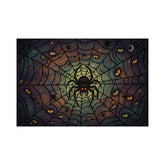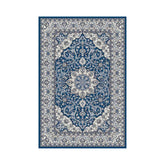Tips For Rugs Care
Tips for rugs care
Regular vacuuming is one of the most fundamental practices for maintaining the integrity and appearance of rugs. Dust, dirt, and debris can accumulate quickly, especially in high-traffic areas. When left unattended, these particles can become embedded in the fibers, leading to wear and tear over time.
A vacuum cleaner equipped with a beater bar or rotating brush can effectively lift dirt from the surface and deep within the pile. For delicate rugs, such as those made from wool or silk, it is advisable to use a vacuum with a suction-only setting to prevent damage to the fibers. In addition to preventing dirt buildup, regular vacuuming helps to maintain the rug's aesthetic appeal.
A clean rug enhances the overall ambiance of a room, contributing to a fresh and inviting atmosphere. It is recommended to vacuum rugs at least once a week, but in homes with pets or children, more frequent cleaning may be necessary. Pay special attention to the edges and corners where dirt tends to accumulate.
By incorporating regular vacuuming into your cleaning routine, you can significantly extend the life of your rugs while keeping them looking their best. Check out our selection of Custom Rugs for a personalized touch to your home decor.
Spot Cleaning
Spot cleaning is an essential technique for addressing stains and spills promptly before they set in. The key to effective spot cleaning lies in acting quickly; the longer a stain sits, the more challenging it becomes to remove. When a spill occurs, it is crucial to blot the area with a clean, dry cloth or paper towel to absorb as much liquid as possible.
Rubbing the stain can cause it to spread or penetrate deeper into the fibers, making it more difficult to eliminate. Instead, gently dab the area and work from the outside of the stain toward the center. After blotting, it is often necessary to use a cleaning solution tailored to the type of stain and rug material.
For instance, a mixture of mild dish soap and water can be effective for food stains, while a vinegar and water solution may work well for pet accidents. Always test any cleaning solution on an inconspicuous area of the rug first to ensure it does not cause discoloration or damage. Once the stain is treated, rinse the area with clean water and blot again to remove any remaining cleaning solution.
Spot cleaning not only helps maintain the rug's appearance but also prevents permanent damage that could result from neglecting spills.
Professional Cleaning
While regular maintenance is crucial, professional cleaning should not be overlooked as part of a comprehensive rug care strategy. Professional cleaners possess specialized equipment and expertise that can effectively remove deep-seated dirt and stains that regular vacuuming and spot cleaning may miss. Many rugs, particularly those made from natural fibers or intricate designs, require specific cleaning methods that are best handled by professionals who understand the nuances of different materials.
Typically, professional cleaning involves a thorough assessment of the rug's condition and material before determining the appropriate cleaning method. Techniques may include steam cleaning, dry cleaning, or even hand washing, depending on the rug's construction. Additionally, professionals can address issues such as moth damage or color bleeding that may arise during routine cleaning.
Scheduling professional cleanings every 1-3 years can help preserve your rug's beauty and longevity, ensuring that it remains a cherished part of your home for years to come.
Rotating the Rug
Rotating your rug is an often-overlooked aspect of rug maintenance that can significantly impact its longevity and appearance. Over time, rugs can develop uneven wear patterns due to foot traffic or exposure to sunlight from specific angles. By rotating your rug every few months, you can help distribute wear more evenly across its surface.
This practice is particularly important for rugs placed in high-traffic areas or those that receive direct sunlight. In addition to promoting even wear, rotating your rug can also refresh the look of your space. A simple shift in orientation can create a new focal point in a room and enhance the overall design aesthetic.
When rotating your rug, take care to ensure that it lies flat and does not create any tripping hazards. This small adjustment can have a significant impact on both the functionality and visual appeal of your home.
Using Rug Pads
Rug pads are an essential accessory for any area rug, providing numerous benefits that enhance both safety and longevity. One of the primary functions of a rug pad is to prevent slipping and sliding on hard surfaces, reducing the risk of accidents in your home. A quality rug pad will grip both the floor and the underside of the rug, keeping it securely in place even in high-traffic areas.
In addition to safety benefits, rug pads also provide cushioning that can help protect your flooring from scratches and dents caused by heavy furniture or foot traffic. They act as a barrier between the rug and the floor, absorbing impact and reducing wear on both surfaces. Furthermore, rug pads can improve comfort underfoot, making your space more inviting.
When selecting a rug pad, consider factors such as thickness, material, and compatibility with your flooring type to ensure optimal performance.
Avoiding Direct Sunlight
Direct sunlight can be detrimental to rugs, particularly those made from natural fibers like wool or cotton. Prolonged exposure to sunlight can cause fading and discoloration, leading to an uneven appearance over time. To mitigate this risk, it is advisable to position rugs away from windows or areas where they will receive direct sunlight for extended periods.
If relocating the rug is not feasible, consider using window treatments such as blinds or curtains to filter sunlight during peak hours. In addition to protecting against fading, avoiding direct sunlight can also help preserve the integrity of the fibers themselves. UV rays can weaken natural fibers over time, making them more susceptible to damage from foot traffic or cleaning processes.
By taking steps to limit sun exposure, you can help maintain both the color vibrancy and structural integrity of your rugs for years to come.
Flipping the Rug
Flipping your rug is another effective strategy for maintaining its condition and appearance over time. Similar to rotating, flipping allows you to expose different sides of the rug to foot traffic and light exposure, promoting even wear across its surface. This practice is particularly beneficial for reversible rugs or those with different patterns on each side.
When flipping your rug, take care to inspect both sides for any signs of damage or wear that may need attention. This is also an excellent opportunity to clean both sides thoroughly before placing it back down. Flipping your rug every few months can help extend its lifespan while ensuring that it continues to enhance your living space aesthetically.
Shaking the Rug Out
Shaking out your rug is a simple yet effective method for removing loose dirt and debris that may accumulate over time. This practice is particularly useful for smaller rugs that can be easily lifted and shaken outside. By taking this step regularly—ideally once a week—you can prevent dirt from settling into the fibers and maintain a cleaner appearance.
When shaking out a rug, be sure to do so gently to avoid damaging its structure or design. It’s best performed outdoors or in an area where dust won’t settle back onto furniture or flooring. After shaking out the rug, consider giving it a quick vacuuming session to pick up any remaining particles that may have been dislodged during shaking.
This combination of shaking and vacuuming will help keep your rug looking fresh while minimizing allergens in your home.
Brushing the Rug
Brushing your rug is an often-neglected aspect of maintenance that can significantly enhance its appearance and texture. Using a soft-bristled brush specifically designed for rugs allows you to gently lift dirt and debris from the fibers without causing damage. This technique is particularly beneficial for shaggy or high-pile rugs where dirt can become trapped deep within the pile.
In addition to removing dirt, brushing helps restore the natural luster of the fibers by untangling them and promoting an even texture across the surface. It’s advisable to brush in one direction rather than back-and-forth motions to avoid fraying or damaging the fibers. Regular brushing not only keeps your rug looking its best but also contributes to its overall longevity by preventing matting and wear.
Avoiding Harsh Chemicals
When it comes to cleaning rugs, avoiding harsh chemicals is paramount for preserving their beauty and integrity. Many commercial cleaners contain abrasive ingredients that can strip natural fibers of their oils or cause discoloration over time. Instead of relying on these products, consider using gentle alternatives such as vinegar solutions or specialized rug cleaners designed for specific materials.
Before applying any cleaning solution—whether homemade or store-bought—always conduct a patch test on an inconspicuous area of the rug first. This precaution helps ensure that no adverse reactions occur that could lead to permanent damage or discoloration. By opting for milder cleaning methods, you not only protect your investment but also contribute to a healthier indoor environment free from harmful chemicals.
Storing the Rug Properly
Proper storage is essential when it comes to preserving rugs that are not in use for extended periods. Whether you are storing seasonal rugs or simply rotating them out for aesthetic reasons, following best practices ensures they remain in excellent condition until they are needed again. Begin by thoroughly cleaning the rug before storage; this step prevents dirt from settling into fibers during storage.
When storing a rug, roll it up rather than folding it; folding can create creases that may be difficult to remove later on. Use acid-free paper between layers if you are stacking multiple rugs together; this helps prevent color transfer and protects against moisture damage. Store rugs in a cool, dry place away from direct sunlight and humidity fluctuations—ideal conditions will help maintain their shape and color until you are ready to bring them back into your living space.
FAQs
What are some general tips for caring for rugs?
- Vacuum rugs regularly to remove dirt and debris. - Rotate rugs regularly to ensure even wear. - Use rug pads to prevent slipping and protect the floor underneath. - Clean up spills and stains promptly to prevent permanent damage. - Professional cleaning is recommended for deep cleaning and maintenance.
How should I vacuum my rugs?
- Use a vacuum with a brush attachment to gently clean the rug. - Vacuum in the direction of the rug's pile to avoid damaging the fibers. - Be sure to vacuum both sides of the rug to remove dirt and debris.
How can I prevent my rugs from slipping?
- Use rug pads underneath the rugs to provide traction and prevent slipping. - Choose a rug pad that is appropriate for the type of flooring underneath the rug.
What should I do if my rug gets stained?
- Blot up the spill or stain immediately with a clean cloth. - Use a mild detergent and water to gently clean the stained area. - For tough stains, consider professional cleaning to avoid damaging the rug.
How often should I have my rugs professionally cleaned?
- It is recommended to have rugs professionally cleaned every 12-18 months, depending on the amount of foot traffic and use.









